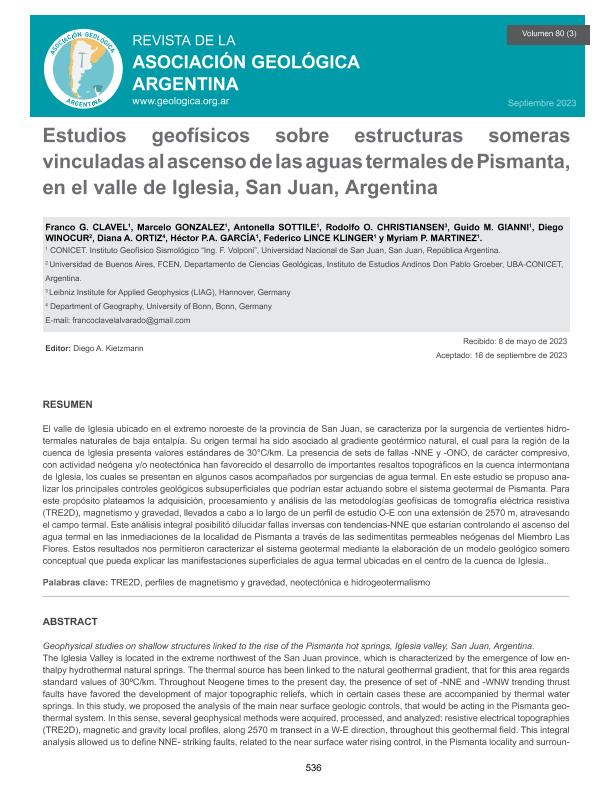Artículo
El valle de Iglesia ubicado en el extremo noroeste de la provincia de San Juan, se caracteriza por la surgencia de vertientes hidrotermales naturales de baja entalpía. Su origen termal ha sido asociado al gradiente geotérmico natural, el cual para la región de la cuenca de Iglesia presenta valores estándares de 30°C/km. La presencia de sets de fallas -NNE y -ONO, de carácter compresivo, con actividad neógena y/o neotectónica han favorecido el desarrollo de importantes resaltos topográficos en la cuenca intermontana de Iglesia, los cuales se presentan en algunos casos acompañados por surgencias de agua termal. En este estudio se propuso analizar los principales controles geológicos subsuperficiales que podrían estar actuando sobre el sistema geotermal de Pismanta. Para este propósito plateamos la adquisición, procesamiento y análisis de las metodologías geofísicas de tomografía eléctrica resistiva (TRE2D), magnetismo y gravedad, llevados a cabo a lo largo de un perfil de estudio O-E con una extensión de 2570 m, atravesando el campo termal. Este análisis integral posibilitó dilucidar fallas inversas con tendencias-NNE que estarían controlando el ascenso del agua termal en las inmediaciones de la localidad de Pismanta a través de las sedimentitas permeables neógenas del Miembro Las Flores. Estos resultados nos permitieron caracterizar el sistema geotermal mediante la elaboración de un modelo geológico somero conceptual que pueda explicar las manifestaciones superficiales de agua termal ubicadas en el centro de la cuenca de Iglesia The Iglesia Valley is located in the extreme northwest of the San Juan province, which is characterized by the emergence of low enthalpy hydrothermal natural springs. The thermal source has been linked to the natural geothermal gradient, that for this area regards standard values of 30ºC/km. Throughout Neogene times to the present day, the presence of set of -NNE and -WNW trending thrust faults have favored the development of major topographic reliefs, which in certain cases these are accompanied by thermal water springs. In this study, we proposed the analysis of the main near surface geologic controls, that would be acting in the Pismanta geothermal system. In this sense, several geophysical methods were acquired, processed, and analyzed: resistive electrical topographies (TRE2D), magnetic and gravity local profiles, along 2570 m transect in a W-E direction, throughout this geothermal field. This integral analysis allowed us to define NNE- striking faults, related to the near surface water rising control, in the Pismanta locality and surroundings, through permeable Neogene sediments of Las Flores Member. These results led us to characterize this geothermal system, through a shallow geological model, that explains the relationship between the hot springs and the local structural-stratigraphic setting.
Estudios geofísicos sobre estructuras someras vinculadas al ascenso de las aguas termales de Pismanta, en el valle de Iglesia, San Juan, Argentina
Título:
Geophysical studies on shallow structures linked to the rise of the Pismanta hot springs, Iglesia valley, San Juan, Argentina
Clavel, Franco Germán ; González, Marcelo; Sottile, Antonella Laura
; González, Marcelo; Sottile, Antonella Laura ; Christiansen, Rodolfo Omar
; Christiansen, Rodolfo Omar ; Gianni, Guido Martin
; Gianni, Guido Martin ; Winocur, Diego Alejandro; Ortiz, Diana A.; Garcia, Hector Pedro Antonio
; Winocur, Diego Alejandro; Ortiz, Diana A.; Garcia, Hector Pedro Antonio ; Lince Klinger, Federico Gustavo
; Lince Klinger, Federico Gustavo ; Martinez, Patricia
; Martinez, Patricia
 ; González, Marcelo; Sottile, Antonella Laura
; González, Marcelo; Sottile, Antonella Laura ; Christiansen, Rodolfo Omar
; Christiansen, Rodolfo Omar ; Gianni, Guido Martin
; Gianni, Guido Martin ; Winocur, Diego Alejandro; Ortiz, Diana A.; Garcia, Hector Pedro Antonio
; Winocur, Diego Alejandro; Ortiz, Diana A.; Garcia, Hector Pedro Antonio ; Lince Klinger, Federico Gustavo
; Lince Klinger, Federico Gustavo ; Martinez, Patricia
; Martinez, Patricia
Fecha de publicación:
09/2023
Editorial:
Asociación Geológica Argentina
Revista:
Revista de la Asociación Geológica Argentina
ISSN:
0004-4822
e-ISSN:
1851-8249
Idioma:
Español
Tipo de recurso:
Artículo publicado
Clasificación temática:
Resumen
Palabras clave:
TRE2D
,
GRAVEDAD
,
MAGNETISMO
,
HIDROTERMALISMO
Archivos asociados
Licencia
Identificadores
Colecciones
Articulos(CCT - SAN JUAN)
Articulos de CENTRO CIENTIFICO TECNOLOGICO CONICET - SAN JUAN
Articulos de CENTRO CIENTIFICO TECNOLOGICO CONICET - SAN JUAN
Citación
Clavel, Franco Germán; González, Marcelo; Sottile, Antonella Laura; Christiansen, Rodolfo Omar; Gianni, Guido Martin; et al.; Estudios geofísicos sobre estructuras someras vinculadas al ascenso de las aguas termales de Pismanta, en el valle de Iglesia, San Juan, Argentina; Asociación Geológica Argentina; Revista de la Asociación Geológica Argentina; 80; 3; 9-2023; 536-557
Compartir



